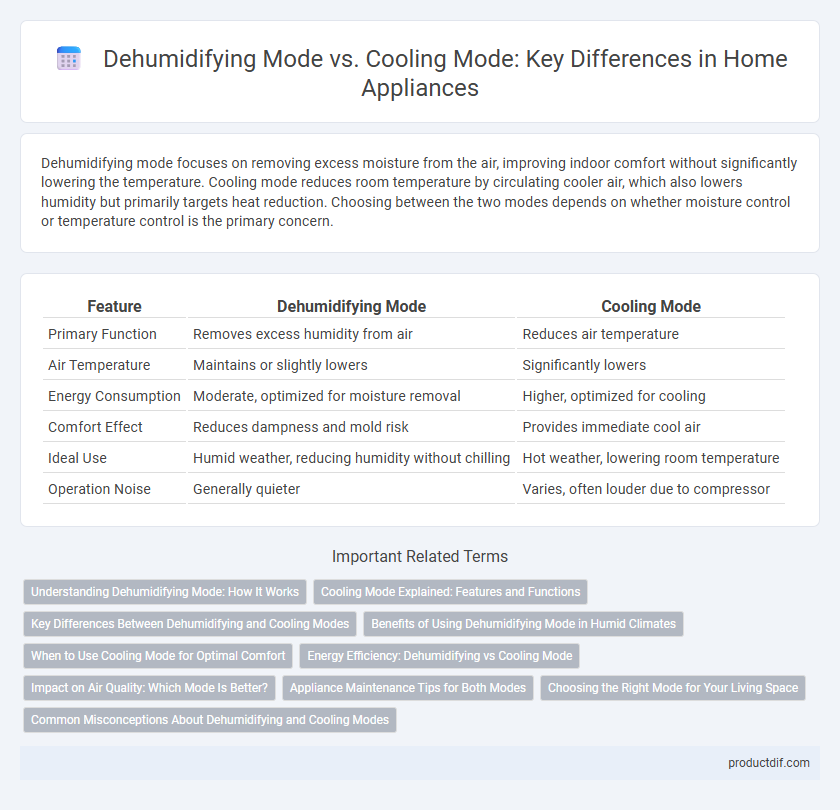Dehumidifying mode focuses on removing excess moisture from the air, improving indoor comfort without significantly lowering the temperature. Cooling mode reduces room temperature by circulating cooler air, which also lowers humidity but primarily targets heat reduction. Choosing between the two modes depends on whether moisture control or temperature control is the primary concern.
Table of Comparison
| Feature | Dehumidifying Mode | Cooling Mode |
|---|---|---|
| Primary Function | Removes excess humidity from air | Reduces air temperature |
| Air Temperature | Maintains or slightly lowers | Significantly lowers |
| Energy Consumption | Moderate, optimized for moisture removal | Higher, optimized for cooling |
| Comfort Effect | Reduces dampness and mold risk | Provides immediate cool air |
| Ideal Use | Humid weather, reducing humidity without chilling | Hot weather, lowering room temperature |
| Operation Noise | Generally quieter | Varies, often louder due to compressor |
Understanding Dehumidifying Mode: How It Works
Dehumidifying mode removes excess moisture from the air by drawing humid air over cold coils, causing water vapor to condense and collect in a reservoir or drain. This process helps maintain optimal indoor humidity levels without significantly lowering the temperature. Unlike cooling mode, which primarily reduces air temperature, dehumidifying mode targets moisture control for enhanced comfort and mold prevention.
Cooling Mode Explained: Features and Functions
Cooling mode in air conditioners lowers room temperature by circulating a refrigerant that absorbs indoor heat and releases it outside, effectively creating a cooler indoor environment. Key features include adjustable thermostat settings, fan speed controls, and energy-saving modes that optimize power consumption while maintaining consistent cooling. This mode also dehumidifies the air to some extent, improving comfort by reducing humidity levels alongside temperature control.
Key Differences Between Dehumidifying and Cooling Modes
Dehumidifying mode primarily reduces humidity levels by extracting moisture from the air without significantly lowering room temperature, making it ideal for damp environments. Cooling mode lowers the ambient temperature by circulating refrigerant and blowing cool air, providing direct relief from heat. The key difference lies in their core functions: dehumidifying targets moisture control while cooling focuses on temperature reduction.
Benefits of Using Dehumidifying Mode in Humid Climates
Dehumidifying mode effectively reduces excess moisture from the air, preventing mold growth and improving indoor air quality in humid climates. It consumes less energy than cooling mode, offering cost-efficient humidity control without significant temperature drops. This mode enhances comfort by maintaining optimal humidity levels, reducing sticky sensations and allergens.
When to Use Cooling Mode for Optimal Comfort
Cooling mode is ideal for hot and humid conditions where lowering the air temperature significantly enhances comfort. It effectively reduces indoor heat and moisture levels when the primary concern is excessive warmth rather than only humidity. Using cooling mode during summer months or heatwaves ensures optimal comfort by maintaining a consistently lower indoor temperature.
Energy Efficiency: Dehumidifying vs Cooling Mode
Dehumidifying mode consumes less energy than cooling mode by targeting moisture removal without significantly lowering the temperature. This mode optimizes power use by running the compressor intermittently, making it ideal for maintaining comfort while reducing electricity bills. Cooling mode, in contrast, requires continuous compressor operation to lower air temperature, leading to higher energy consumption.
Impact on Air Quality: Which Mode Is Better?
Dehumidifying mode effectively reduces excess moisture levels, preventing mold growth and improving indoor air quality by creating a less hospitable environment for allergens and dust mites. Cooling mode primarily lowers air temperature but does not specifically target humidity control, which means moisture-related air quality issues may persist. For optimal air quality improvement, dehumidifying mode is superior as it directly manages humidity, enhancing comfort and health in indoor spaces.
Appliance Maintenance Tips for Both Modes
Regularly clean the air filters and coils in appliances operating in both dehumidifying and cooling modes to maintain optimal efficiency and airflow. Inspect and clear the drainage system frequently to prevent clogs and water damage, especially in dehumidifying mode where moisture removal is constant. Schedule routine professional maintenance to check refrigerant levels and system components, ensuring long-term appliance reliability and energy savings.
Choosing the Right Mode for Your Living Space
Selecting the appropriate mode for your living space depends on humidity levels and temperature needs; dehumidifying mode effectively reduces moisture without significantly altering room temperature, ideal for damp climates. Cooling mode lowers the ambient temperature while also providing some moisture removal, making it suitable for hot, humid environments. Understanding the climate and your comfort preferences ensures efficient energy use and optimal indoor air quality.
Common Misconceptions About Dehumidifying and Cooling Modes
Dehumidifying mode primarily reduces indoor humidity by extracting moisture from the air without significantly lowering room temperature, contrary to the common misconception that it cools the space like cooling mode. Cooling mode decreases both air temperature and humidity by circulating cold air, often resulting in a cooler but less humidity-controlled environment. Understanding these distinctions helps optimize appliance usage, ensuring energy efficiency and comfort tailored to specific needs.
Dehumidifying Mode vs Cooling Mode Infographic

 productdif.com
productdif.com